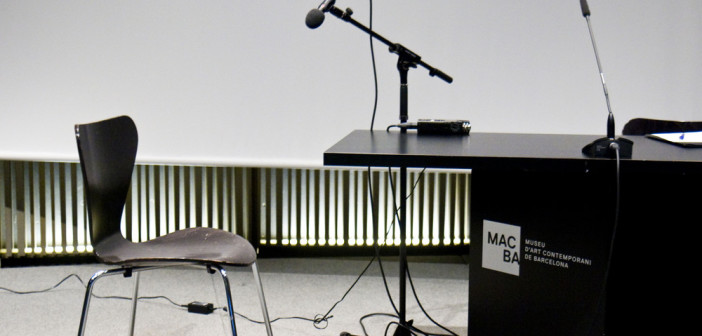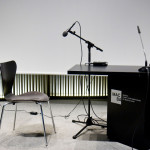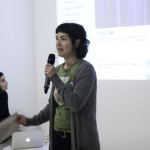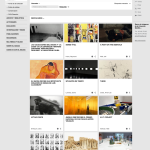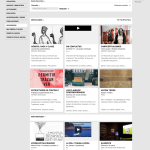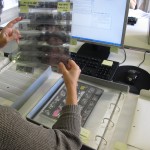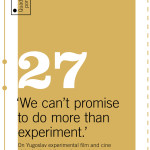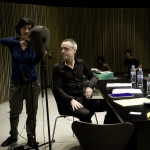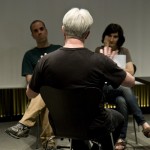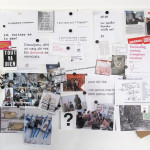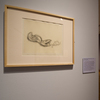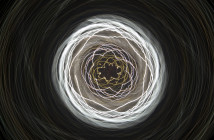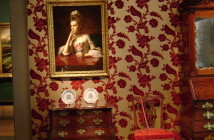Barcelona's Museum of Contemporary Art (MACBA) opened its doors in the city's Raval district in 1995, though its Foundation dates back to 1987, when a broad cross-section of Catalan civil society and private companies created the MACBA Foundation. The Foundation, together with the Government of Catalonia, Barcelona's City Council and the Ministry of Culture, form the MACBA Consortium, whose founding mission was to manage the Museum and establish a permanent collection representing current trends in Contemporary Art.
Early in 2012, after a long period of conceptualization, the Museum launched a redesigned website (macba.cat). It includes new features such as Itineraries (Recorridos), which allow users to create collections of content from the roughly five thousand works that constitute the MACBA Collection, along with all the media available on the website's database (videos, artist biographies, podcasts, publications, etc.) which was expanded recently by the merger of the MACBA Collection database with the Archives of its Study Center.
Ràdio Web MACBA, the Museum's radio project, established in 2006, has its own website rwm.macba.cat. It includes a selection of over 250 podcasts and documents on art, philosophy, and experimental music, with the aim of encouraging critical depth in the fields of sound production and contemporary thought.
•••
Latitudes: MACBA launched its new website in early 2012 after a period of redesign and conceptualization. What elements most urgently needed to change with respect to the previous website?
Sònia López: The first motivation for the redesign was a need for improved strategies of content presentation and management, and while that wasn't the only reason, it certainly shaped the project as a whole. The MACBA website had been strongly centered on content creation and publication, and, for various reasons, other aspects that needed addressing, such as technical and navigational improvements, had been postponed for over five years. Even in the early years of the web 2.0 explosion, when many proclaimed unreservedly that websites, cultural or not, had to shift to the user and launch into social media, we were prudent in this area. Our media presence on the net was very scattered and had little impact on the web page. We had to sort through all of this and take the redesign as an opportunity to experiment a little. In general, this new platform should also allow us to continue extending the scale of the project, which had been exhausted on the previous website.
L: Just as traditional newspapers have been forced to rethink the type of business they operate (that is, not only in the print business, but a metamorphosis into digital platforms), what role do you think the MACBA website and Ràdio Web MACBA (RWM) play in relation to the museum, which traditionally focuses on collecting, preserving and presenting artistic objects?
SL: I think one of the pillars of the "MACBA model" is precisely this belief that heritage goes beyond the works in the collection. The museum's capital consists of artworks, of course, but also of documents, research processes, ideas, and readings that the museum generates alongside the collection. This led, in recent years, to the creation of the Study Center and the Independent Studies Programme. However, this model was in conflict with the structure of the old website, which responded to a content management system we used to make published content grow. Conceptually, we felt it no longer conveyed information in a manner that fit the MACBA learning style.
Throughout the redesign process, the basic idea was to restructure the website into a decentralized system. The home page presents cascading content: some elements form a nucleus (exhibitions and events, mostly) around which documents, publications, audio-visual and other artworks, etc., appear. However, any single element is also nuclear: a video, a publication, a press release, and naturally talks and public programs, as well as the rest of our content. When the website was re-imagined, we pictured it well-organized visually and wanted to show related content without imposing hierarchies—content that could even be flexible and customized by the user. This didn't make it off the wish-list and into the final design, but we tried to stay true to this idea that any single piece of content can become the trigger for how a user navigates. The column "related content" that accompanies most of page layouts resulted from this idea.
With this redesign we also made public a catalogue of content including both the holdings of the MACBA Collection and the Archives of the Study Center. We've just now completed the second phase of the project that unveils the full scope of this part of the website: both collections are catalogued in a single database. The search engine returns the combined results from both sources with the intention of promoting multiple possible relationships between the elements found in these two sources.
L: We imagine that there were other elements from your wish-list that you inevitably had to discard. What were they? We'd also be interested to know which references, resources and institutions inspired you during the renewal process.
SL: There were, but we are not ruling out further development as resources permit. To name a few examples: we'd like to be able to visualize some of the data published online, like MACBA's various traveling projects—works, exhibitions and related publications—on geographical maps, and similarly with the origin of the artists. Another big pending project is the creation of a good tagging system to describe content. Sydney's Powerhouse Museum and the Brooklyn Museum in New York are both good examples of how tags can coexist with standardized records. The Brooklyn Museum—not only on this project— has been and continues to be a font of inspiration because of the simplicity and clarity with which all of their content is accessed, and for their commitment to building trust and proximity with web users. I admire how well aligned the mission of the web project is with the mission of the institution itself. They had a strong influence on this redesign: we wanted to incorporate the way they enable web users to comment on almost all of the web content. The Walker Art Center in Minneapolis [Latitudes' first #OpenCurating interview] was also a reference, but I believe it's essential, when working on a public or institutional project, to have a clear scope for the project and discern what fits best with the museum's mission and what doesn't. Copying is allowed but you have to digest all the ideas out there first.
 macba.cat/en/holdings
macba.cat/en/holdings21 November 2012
Project led by the MACBA Web Team
Graphic Design: todojunto
Programming: Omatech
L: Through our #OpenCurating research, we're trying to analyze changing approaches in journalism, especially in print media, with the introduction of new practices of so-called Open Journalism. An open and continuous dialogue with both the reader and other supplementary sources, Open Journalism is more of a continuous process rather than a finished story. We're looking at how, or in what manner, these changes are being translated into curatorial practice in contemporary art. It's in this sense that the term #OpenCurating became the title of the research project. In this context, let's turn to the practice of allowing users to comment on the works of the collection. How does anyone the institution respond and turn those comments into a conversation, for example? And specifically in terms of interface design, what other elements help generate and sustain the desired conversation; how do you reach or exceed the desire for interactivity?
SL: I think there are several issues to consider: on one hand, creating a space for comment is not synonymous with dialogue. Neither is having many followers, mentions or comments on social media networks. The dialogue between the institution and the public is something tremendously complex to achieve because of the interplay of many variables. I truly believe that this is something you can achieve if you take risks: conversation and interactivity are actions that require a lot of spontaneity, the acknowledgement of multiple voices (within the institution itself), and accepting you might be wrong in the face of a large audience. In short, the institution has to exercise honesty and show a real will to engage the public. That's not something you achieve overnight simply by putting together a good-looking website containing all the right tools. You have to use the instrument of debate properly, since we compete with platforms that are perhaps more natural to the public, such as blogs and other social networking sites. It doesn’t make sense to try and pull all the conversation to our website—we don’t want to burden it further—but web comments can form a space for further debate between users and curators—a sort of open channel. We're working to make this a reality. We'd like the institution to stop imposing and become a space for debate and reflection.
| The MACBA website tries to account for the different stories and viewpoints in existence (within and beyond the museum), and particularly attempts to incorporate a history that critiques hegemonic ideas and that encourages institutional critique |
L: With regards to this desire for dialogue, and on the subject of an institution rethinking its website, in the first interview of the #OpenCurating series, the web team at the Walker Art Center discussed the wish to tell their own institutional history, to put the collection in context, and to begin a dialogue with their audience, both locally and online. Their website marks a paradigm shift in that it has been redefined as a periodical publication, where content is generated and edited practically daily, where relationships are established with other media online (discussion platforms, magazines, opinion columns ...) and with printed media. This also applies to the new website of the New York-based organization Creative Time, which in October launched Creative Time Reports, an online platform in which artists discuss issues of concern in today's world. Do you think that this could be a possible direction to explore in the near future? How do you think that the different voices of the museum are reflected the MACBA website?
SL: The MACBA website tries to account for the different stories and viewpoints in existence (within and beyond the museum), and particularly attempts to incorporate a history that critiques hegemonic ideas and that encourages institutional critique—a paradox, admittedly. I believe that our website offers sufficient resources to give visibility to this approach, thanks to a continuous production of content. These are not only the fruit of the museum's activity but also of its own creations: I think the best example of this is RWM, specifically two lines of programming: Especiales (Specials) and Son[i]a.
L: Another element you've added to the new website are the Itineraries. These groupings of audio files, videos, artist biographies, artworks, texts, publications and more, belonging to the MACBA collection, can be produced by any user, or by a museum team, either for one's own enjoyment, or for academic investigation, or perhaps for artistic purposes. They allow a non-linear visit of the collection by incorporating diverse elements. Do these Itineraries suggest that a single, authorized narrative, approved by the institution, is no longer viable? What feedback have you received about in their use? What purpose do they serve for the museum beyond being available on the Web?
SL: The Itineraries evolved from a simple idea: the"favorites" or browser bookmarks that are saved to enable transversal reading. They can turn into something simple or sophisticated, depending on the user. This flexibility seemed necessary if one hopes to provide something people are eager to use. The basic idea is precisely to emphasize that attitude you mentioned: the items that are selected, their order, the notes that are written about them (these notes are a little-known feature of the Itineraries), each of these factors allows users to exert curatorial control over our holdings. Interpretations multiply and generate a space for debate, since each Itinerary can receive comments from other users. This type of approach would be the profile of our "ideal user", one that will enable the testing of the limits the tool. I can't help giving some examples of user-created Itineraries that I've found interesting: The unfinished "Àngels Ribé. Trs puntos uno" by Frida, "Estado del terror. El miedo como estrategia política" (Terror State. Fear as Foreign Policy) by Cheshire, or "Top 10+1 Favourite exhibitions" by Ched. Each of these offers a picture of what can be achieved with the tool. Museum staff often uses them to pull together content that complements the institution's lines of inquiry. "Sis conflictes" is a recent example including collected notes and external links, materials cited by Jorge Luís Marzo during the last session of his October 2012 seminar. But we realize much work remains before we unlock the potential the Itineraries present both outside and within the museum.
 Cataloguing negatives and contact sheets from the Miserachs archive, for which the Study Center has been the repository since 2011.
Cataloguing negatives and contact sheets from the Miserachs archive, for which the Study Center has been the repository since 2011.Photo: Estel Fabregat, 2012
L: Continuing with the potential of these Itineraries: how else could you involve the visitors physically or online in contributing to, or even collaborating with, the holdings of the museum?
SL: A few days ago, in a working session with our colleagues at the Study Center Archives and Library, we were asked if we might enlist the support of our Flickr users to identify spaces and landscapes in images from the photographic archives of Xavier Miserachs, mostly images taken in the 1950s. We gave it some thought, then realized it would probably make more sense to reach out to older generations of people, and collect information using a more 'analog' method. The public can contribute in many ways; the key is to make a clear proposal to the audience you want to connect with and to provide the right tools.
L: It’s interesting to consider the idea of a personal itinerary in a way which might suggest that artworks and archive material are "consumable" goods. By choosing a route through the content, the role given to the web visitor is not unlike that of a tourist navigating the city in search of a series of "authentic" experiences. Could you comment on what impression the Itineraries give the visitor, real or virtual, of navigating the collection?
SL: Itineraries can serve many purposes. Driven by popular demand, we're tempted to create one called "MACBA: Ten Works You Shouldn't Miss", but have yet to do it. We'd like the exercise we propose the public to be unique—they can create a map permitting individual thought and decision-making. To quote our Chief Curator, Carles Guerra, visiting a museum like MACBA offers "a sophisticated appropriation of the works, the creation of an interpretation." The objects don’t speak by themselves, they only convey whatever we project onto them, and because of how we place the works in relation to one another. The Itineraries attempt to follow this model, to facilitate the creation of interpretations and to allow them to be shared.
| MACBA offers "a sophisticated appropriation of the works, the creation of an interpretation." |
L: We'd also like to discuss your editorial approach, in particular some of the formats you handle which are different from traditional print publications. We're thinking of the Quaderns Portàtils (Portable Notebooks), whose content comes primarily from conferences and seminars that have taken place at the museum, Quaderns d'Audio (Audio Notebooks) related to Ràdio Web MACBA (RWM) programs, or those produced to accompany the exhibition held at La Capella, which are distributed online for free.
Which directions and formats do you intend to explore in the future—especially considering the economic downturn—to be able to continue publishing? Do you think the future of publishing will be purely digital? Do you dare predict what types of tools will soon emerge?
SL: With the Portable Notebooks design team we've just begun adapting the collection to the ePub (the next issue will be published both as a PDF and in an ePub format for standard readers.) We've been thinking about this. Do we get rid of the collectable booklets? No, we won't do that. Do we create several ePub formats, one for each type of reader? No, we'll stick to one standard format. We want to maintain the character of the collection, yet for accessibility and ease of use, allow the text to be loaded on mobile devices. "We can't promise to do more than experiment."
The publishing landscape is confusing because there are many unknowns and possibilities on the table, with few assurances that any one format will win the race. Nevertheless, I believe that when it comes to publications by museums such as MACBA, where the catalog is a reflection of a curatorial discourse, a paper format (or PDF, the text's state prior to printing) has practical characteristics that will continue to be valid for quite a long time. Design is at the service of an idea; editing and dialogue between text and image conveys meaning. In theory, this can also be achieved with an app—an obvious example is Al Gore's book Our Choice— but frankly, I bought it and have not managed to overcome the feeling of being in game mode. Reading becomes something else: there is so much interactivity that I feel more like I'm playing than reading. This isn't all bad, and I think it has great potential, but I don’t see it as the alternative (either economically or conceptually) to traditional publishing in a museum context. It's a further possibility, one that adds something but cannot replace.
Anna Ramos: When it comes to the audio world, in the West, curiously, there is a resurgence of the cassette, and vinyl as you know has maintained a market niche to the point where some major labels are beginning to produce it again. These objects coexist with now ubiquitous digital formats and the gradual implementation of platforms that implement different systems and business models (the range of services is so varied, from the iTunes Store to Spotify, SoundCloud, Mixcloud, YouTube, RapidShare, etc.,) facilitating and expanding access to digital files. In a recent conversation with library music collector Jonny Trunk, he pointed out that big franchises like HMV, FNAC and Virgin are devoting large spaces in stores to the sale of LPs. Or, speaking the other day with Shakira from Wah Wah Records, a record store for record collectors in Barcelona, she explained that vinyl is their biggest source of income. The omnipresence of the digital experience is not necessarily antagonistic with the object: the two are moments and experiences that are complementary, not exclusive.
According to Antonio Ramírez (Manager of La Central bookstore in Barcelona and Madrid), recently interviewed on RWM, the impulse to buy an object, thereby translating an experience to a physical souvenir, still exists. Economically speaking, projects should take a more reasonable dimension and scale, and profit margins should be considered to counterbalance a desire to make things. The need to feel surrounded by objects, with which we can identify and build up our identity, persists beyond the Web. One advantage to working in the art world is that, in its very nature, this need to generate objects and content often takes precedence over the profitability criteria that are applied to other commodities. It's in the art world’s DNA and it is partly expected of us. This is obviously increasingly difficult given the current climate, but it will continue to be there, to a greater or lesser degree. Perhaps art centers will go without publications departments, or publications departments will produce everything in digital formats, but artists will continue to create artists' books, even if they are made with photocopies, facsimiles or using high-speed color printers like RISO.
 Anna Ramos in a recording session with British music collector William Bennett.
Anna Ramos in a recording session with British music collector William Bennett.Photo: Gemma Planell / MACBA 2012
L: From your perspective, how are artistic practices responding to this change which, to paraphrase the North American journalist Jeff Jarvis, could be summarized as a transition from ink to link?
AR: We could use the example of Barcelona's cultural collective L'Automàtica, which found an old printing press and is producing small format projects. It's a local example I find admirable and inspiring because, despite using artisanal or even antiquated technology, the project is capturing the imagination of the artistic fabric of the city and is leading to hybrid projects (bridging between the workshop, artist residency and performances), which go beyond the physical object and the printing process, and approaches an idea of collective production, co-creation or the sum of accumulated intelligences and experiences in different creative fields. The project also has a really interesting social dimension, because it allowed for an out-of-business craftsperson, who was going to sell off machines for scrap metal, to become part of the project and even to participate creatively as an equal partner. This is a local example of something that is occurring elsewhere: the return to letterpress, printing and craft. These are cases that go beyond the scope of our institution, but they can help us understand that, parallel to the failure of certain business models, new opportunities and ways of achieving things are springing up, and there are many artists who belong to, and mature within this underground economy. This model of reviving traditional printing techniques can be found elsewhere in Spain, for example at La Familia Plómez, Oficio, El Calotipo, Bruta-Bruta and Bunker Type, among others. This is no coincidence: we're looking at a global trend.
In another of our recent radio podcasts, Mexican artist Erick Beltrán shared a personal experience that I found particularly interesting: art school students in Mexico used to favor a brand of Spanish paper called Guarro to make sketches, drawings and other works on paper, believing it would give credibility to their work. After several currency devaluations, the paper could no longer be imported, so instead students began looking for materials that were close at hand and affordable: car tires, graffiti, etc. This proves that the impulse is there: even on a different scale, even in the face of adversity, fetishism and physical experience still find a place and exist alongside the digital experience, and will likely become more and more sophisticated and complex, which is fantastic.
L: Speaking of sophistication and complexity, do you believe museums should engage more with the current technological advances? On which efforts and tools do you think they should focus their attention?
AR: Recently, at the Second International Forum of Cultural Spaces (II FIEC), Shelley Mannion, head of the British Museum's Samsung Digital Discovery Centre, explained that museums and art centers are facing a very pressing challenge in addressing the paradigm shift brought about by how new generations learn and interact with gadgets from a very young age. She also spoke about different methods we can use to include the user in the story, and that the model that we uphold is only one model; there are people for whom the learning curve is intensified through narrative gadgets which are not as linear as text. If we fail to reinvent ourselves, it's likely the future generation won't understand what's going on inside the Museum's walls. Perhaps we have to find a balance between these tensions—object vs. digital—and to present a rich ecosystem where they complement one another. Personally, I think we shouldn't lose sight of the fact that we are a space which can be a laboratory of experimentation, and that we have the opportunity to involve artists in the process.
Other great minds, such as Rick Prelinger, examine these long-term tensions: the conservation of materials and physical objects is problematic, but we have a cumulative experience that gives us an idea of how to conserve them. How are we going to preserve the huge digital capital that our society generates? Since the fall of Napster and the migration of content to the cloud, Kenneth Goldsmith, the man behind Ubuweb, doesn’t tire of repeating "don't trust the cloud." Among other challenges, the services will only be there as long as the companies that invented them last and don’t change their minds or approach. And if the cloud persists, how are we going to manage its volume and ubiquity? And what happened to the formative value of loss? We've talked about issues such as these with Perejaume, Wolfgang Ernst and Rick Prelinger and I highly recommend listening to the latter's thoughts on the subject.
SL: I think our priority should always be content. The tools used have to be at the service of content and serve the mission of disseminating it. One has to deploy new resources, but without magnifying the value of the digital per se.
L: Let's talk positively, about the fantastic audio resource of the RWM, its inception in 2006 and any future challenges. In her presentation at the Second FIEC, Anna maintained that RWM was established as a space for creating content, that the museum's radio and website can deal with similar themes but will be approaching them in parallel. Going beyond just asking you how you feel about the health of RWM, could you talk to us about how a 19th century technology like radio can adapt to the age of social networks?
AR: A few weeks ago, we spoke with François Pain, creator of one of the first free radios in Europe, France's Radio Tomate. His model was riddled with the ideas of French philosopher Félix Guattari, and his experiment in pre-Internet programming was far ahead of our current communication trends (preceding the current use of tools like Twitter to mobilize activists in demonstrations). In his case, they mobilized crowds using the Minitel. Franco "Bifo" Berardi, another protagonist in this story, called it "Comunicación de carretera" (Guerrilla Communication). You will be able to listen to Bifo's story in a Special podcast about Radio Tomate and his prior experience with Bologna's Radio Alice—our interview was eye-opening. Here we are, a few decades later, facing a crisis of our structures and values, and a very different technology is making us discover the potential the proximity of human voice and first person speech can have.
We're living the RWM project a sort of multi-layered choral experience, from the activity of the Museum (a space with a continual flux of minds and experiences), to our guest contributors, and, why not, to the complicity of the sound artists, musicians and music lovers in the production and aesthetic decisions of the final edit. In a time of social networking and participation, an art center remains in a privileged place. With today's methods, we can give voice and space to many stories that only get a passing mention in traditional communication media: because of the same economic logic that is crushing us all, they have to give priority to profitability and to the tendencies and impulses of the market. With scant resources, this project, built by a multitude of voices, has extraordinary potential. Radio equipment can be as small as a digital recorder, a microphone and computer, and yet as big as the infinity of experiences, histories, intuitions, theses, theories and obsessions of those who join us in the laboratory.
| We share a dedication to curatorial practices; we make visible and share our processes of investigation, and we give access to exciting stories and narratives, and in many cases told first-hand |
Furthermore, we're taking stock of our role as a repository of podcasts, and the action of adding and accumulating other contributions brings us closer to becoming an archive. We'd be mistaken in stating that RWM is an exhibition space for sound art, as is often assumed because the primary material we work with is audio. Sound art and music deserve spaces that privilege the listening experience, and where the artist can make decisions pertinent to his or her vision. But perhaps we can start thinking of this project as a chronicle that approximates the digital archive, in which sound art, together with contemporary thinking and radiophonic art, examine one another and sometimes even happen. As we said before, working in an art center nowadays is becoming a luxury, and the drastic changes we are experiencing at many levels could change access to knowledge and how we know what we know. For that reason we show support to projects such as ours, and to Ubuweb, Resonance FM, WFMU, Sonosphere.org, RRS, Hots! Radio, SONM, ICA Soundworks and other archives and radios online that offer so much more than data: we share a dedication to curatorial practices; we make visible and share our processes of investigation, and we give access to exciting stories and narratives, and in many cases told first-hand.
Having said that, we still need to improve our information architecture, our optimize our search engines, and the project interface. We have focused on the contents to better discover the potential of this small laboratory of sound and voice, and its viability. We urgently need to adapt our tools to provide more organic navigation, linked and cross-referenced internally.
L: What directions are you exploring to resolve these technical urgencies? Or to put it another way, what's the wish-list for RWM?
AR: True to the collective spirit of the project, we are in the initial phase of exchanging ideas with our collaborators. It is too early to say what the new interface of RWM will look like, but we know we want to incorporate pull-quotes, more mechanisms that encourage serendipitous browsing, and of course facilitate conversations along themes we're examining on the platforms where these are currently happening, namely social networks and specialized forums.
L: To end, we'd like to ask about RWM's EXTRA section, where you share audio and text material that generally hasn't made it into the final cut of the interviews. Showing "behind the scenes" material is very much in vogue and popular right now, either on TV shows with outtakes, on DVDs with "making of" documentaries, or on Flickr where exhibition installation, restoration, collection maintenance, graphic design work, etc. is shared with the public. Numerous institutions are developing initiatives with the aim of increasing transparency and going further than simply divulging their budgets. In Spain, for example, ARTIUM in Vitoria-Gasteiz is making all of its accounts public. The Antoni Tàpies Foundation in Barcelona is preparing to open up their Archive-Thesaurus on a dedicated website. Called a "Rear Window" to the creative work of the Foundation, they are sharing their "iconographic references, the repositories used to date, as well as the texts, interfaces, networks, [and]displayed archives." In Europe, the Van Abbemuseum in Eindhoven [the subject of another #OpenCurating interview]has organized public visits of their storage rooms, archives, and so on. Beyond being a decision imposed by the upper echelons of the Museum, is this an exercise in "self-archiving" you would want to promote on your websites, both RWM and MACBA's? Do you think it is something that will work well?
 The Publications Department's collection of mementos and memorable phrases.
The Publications Department's collection of mementos and memorable phrases.Photo: Gemma Planell / MACBA 2012
SL: Absolutely, this is something the public likes and that from the museum's standpoint we find quite enjoyable. The "MACBA viu" Flickr page, or the latest "RWM. Entre bambalinas"(Behind the Scenes), came about naturally through the desire to preserve special moments: working meetings, the visit of an artist for a recording, the documentation of everyday moments and work processes. I believe that we've been able to give an inside peek at daily life in the Museum. We want to include the public in this project, and we invite visitors to use hash-tags and join the social media feeds. The contributions of visitors and museum staff have equal value. The Museum is a sum of these two centers of activity: public and private.
AR: One of the boons of a project like RWM is that it allows us to delve deeply into a theme, and explore it without time constraints, or requiring the attention span needed for traditional media. Alongside this, the online format allows us and even pushes us to collect content, leading us inevitably to the creation of a chronicle of a continuous present, fixed in time.
The idea of sharing some behind the scenes radio processes was something that surfaced naturally: we simply realized that our research and project creation was gathering very interesting material, stuck in our hard drives, that could be shared to help to deepen and complement different lines of programming. It's very diverse material, from deleted scenes—culled from marathon interviews—to transcripts of podcasts. In the EXTRA section, we've also published conversations with artists, curators and collectors that were produced during our research. Concepts such as "documentation" and "processes" are objects of interest at MACBA, so sharing them in the radio format is consistent with our internal logic. The truth is that they work just as well as the final programs, and frequently they go beyond playing a supporting role. The conversations are a perfect example. It's not so much an exercise of self-archiving as it is measuring the value of certain processes, bringing to light the rigorous research behind the podcasts.
We'd begun to think of ourselves as an archive, but after several conversations on the subject with the aforementioned Wolfgang Ernst, Erick Beltrán and Rick Prelinger, I believe that we have to be more specific and present ourselves as what we really are: a hybrid of two or more types of entities. We have the same issue with content: we find ourselves in a no-man's land in which sound art, audio essays, documentaries, chronicles and radiophonic art coexist. The most interesting aspect of all this is the flexibility and the capacity to adapt to what is most interesting or fitting to each medium or language.
- The radio studio of Ràdio Web MACBA in the MACBA auditorium. Photo: Gemma Planell / MACBA 2012
- Sònia López presents the new web project. 17 January 2012 Photo: Gemma Planell / MACBA 2012
- macba.cat/en/holdings 21 November 2012 Project led by the MACBA Web Team Graphic Design: todojunto Programming: Omatech
- Itineraries (Recorridos) 21 November 2012
- Cataloguing negatives and contact sheets from the Miserachs archive, for which the Study Center has been the repository since 2011. Photo: Estel Fabregat, 2012
- Ana Janevski, “We can’t promise to do more than experiment.” MACBA Portable Notebooks, 2012
- Anna Ramos in a recording session with British music collector William Bennett. Photo: Gemma Planell / MACBA 2012
- Recording session with Rick Prelinger, archivist and architect of the Prelinger Archives. Photo: Gemma Planell / MACBA 2012
- The Publications Department’s collection of mementos and memorable phrases. Photo: Gemma Planell / MACBA 2012
* This interview, originally conducted in Spanish on 28 November, 2012 and titled "Itinerarios Transversales: Entrevista con Sònia López y Anna Ramos," is the third of Latitudes' ongoing #OpenCurating interviews. Latitudes and the Walker Art Center in Minneapolis are content collaborators on this project.
It was translated for Big Red & Shiny by Miguel Miró-Quesada, and edited by Stephanie Cardon.

